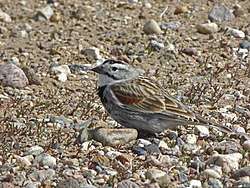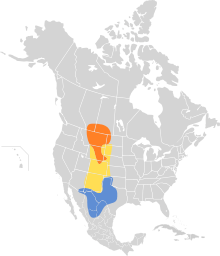McCown's longspur
| McCown's longspur | |
|---|---|
 | |
| Scientific classification | |
| Kingdom: | Animalia |
| Phylum: | Chordata |
| Class: | Aves |
| Order: | Passeriformes |
| Family: | Calcariidae |
| Genus: | Rhynchophanes Baird, 1858 |
| Species: | R. mccownii |
| Binomial name | |
| Rhynchophanes mccownii Lawrence, 1851 | |
 | |
The McCown's longspur (Rhynchophanes mccownii) is a small ground-feeding bird from the family Calcariidae, which also contains the longspurs and snow buntings.
Description
These birds have a large cone-shaped bill, a streaked back, a rust-coloured shoulder and a white tail with a dark tip. In breeding plumage, the male has a white throat and underparts, a grey face and nape and a black crown. Other birds have pale underparts, a dark crown and may have some black on the breast. The male's song is a clear warble. The call is a dry rattle.
Behaviour
In winter, they migrate in flocks to prairies and open fields in the southern United States and northern Mexico. They prefer areas with sparser vegetation than those chosen by the chestnut-collared longspur. These birds forage on the ground, gathering in flocks outside of the nesting season. They sometimes make short flights in pursuit of flying insects. They mainly eat seeds, also eating insects in summer. Young birds are mainly fed insects. This bird breeds in dry short grass prairies in central Canada, (the Canadian Prairies), and the north central United States. The female lays 3 or 4 eggs in a grass cup nest in a shallow scrape on the ground. The male sings and flies up to defend his territory. Both parents feed the young birds.
The numbers and range of these birds have declined since the early 1900s due to habitat loss.
This bird was named after Captain John P. McCown, an American army officer.[2]
References
- ↑ BirdLife International (2012). "Rhynchophanes mccownii". IUCN Red List of Threatened Species. Version 2013.2. International Union for Conservation of Nature. Retrieved 26 November 2013.
- ↑ Beolens, Bo; Watkins, Michael (2003). Whose Bird? Men and Women Commemorated in the Common Names of Birds. London: Christopher Helm. p. 224.
Further reading
Book
- With, K. A. 1994. McCown’s Longspur (Calcarius mccownii). In The Birds of North America, No. 96 (A. Poole and F. Gill, Eds.). Philadelphia: The Academy of Natural Sciences; Washington, D.C.: The American Ornithologists’ Union.
Articles
- Crins WJ. (2006). Ontario Bird Records Committee Report for 2005. Ontario Birds. vol 24, no 2. p. 54-74.
- Greer RD & Anderson SH. (1989). Relationships between Population Demography of Mccown's Longspurs and Habitat Resources. Condor. vol 91, no 3. p. 609-619.
- Klicka J, Zink RM & Winker K. (2003). Longspurs and snow buntings: phylogeny and biogeography of a high-latitude clade (Calcarius). Mol Phylogenet Evol. vol 26, no 2. p. 165-175.
- Lynn SE, Hunt KE & Wingfield JC. (2003). The adrenocortical response to stress in grassland birds: Reexamining ecological influences on the stress response during breeding. Integrative and Comparative Biology. vol 43, no 6.
- Lynn SE, Hunt KE & Wingfield JC. (2003). Ecological factors affecting the adrenocortical response to stress in chestnut-collared and McCown's longspurs (Calcarius ornatus, Calcarius mccownii). Physiol Biochem Zool. vol 76, no 4. p. 566-576.
- Maher WJ. (1979). Nestling Diets of Prairie Passerine Birds at Matador Saskatchewan Canada. Ibis. vol 121, no 4. p. 437-452.
- Martin PA & Forsyth DJ. (2003). Occurrence and productivity of songbirds in prairie farmland under conventional versus minimum tillage regimes. Agric Ecosyst Environ. vol 96, no 1-3. p. 107-117.
- McEwen LC, Deweese LR & Schladweiler P. (1986). Bird Predation on Cutworms Lepidoptera Noctuidae in Wheat Fields and Chlorpyrifos Effects on Brain Cholinesterase Activity. Environmental Entomology. vol 15, no 1. p. 147-151.
- Ornelas JF, Del Coro Arizmendi M, Marquez-Valdelamar L, De Lourdes Navarijo M & Berlanga HA. (1993). Variability profiles for line transect bird censuses in a tropical dry forest in Mexico. Condor. vol 95, no 2. p. 422-441.
- Powell DJ. (1981). Michigan USA Bird Survey Spring 1981. Jack Pine Warbler. vol 59, no 3. p. 105-112.
- Read PA. (2006). McCown's Longspur: New to Ontario. Ontario Birds. vol 24, no 2. p. 88-91.
- Smith LM, Haukos DA & Prather RM. (2004). Avian response to vegetative pattern in playa wetlands during winter. Wildl Soc Bull. vol 32, no 2. p. 474-480.
- Webster JD. (1984). Richardsons Mexican Collection Birds from Zacatecas and Adjoining States. Condor. vol 86, no 2. p. 204-207.
- With KA. (1994). THE HAZARDS OF NESTING NEAR SHRUBS FOR A GRASSLAND BIRD, THE MCCOWNS LONGSPUR. Condor. vol 96, no 4. p. 1009-1019.
- With KA & Webb DR. (1993). Microclimate of ground nests: The relative importance of radiative cover and wind breaks for three grassland species. Condor. vol 95, no 2. p. 401-413.
- Wright DH. (1996). Intermittent birding at Prince Albert, 1982-1985. Blue Jay. vol 54, no 3.
External links
- McCown's Longspur videos on the Internet Bird Collection
- McCown's Longspur photo galley VIREO
- Photo-High Res--(Close-up); Article – (photo gallery)
